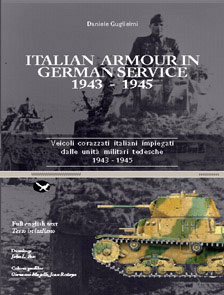Italian Armour in German Service
1943–1945
by Daniele Guglielmi

Published by Mattioli 1885, ISBN: 88-89397-17-9, Year: 2005, Pages: 314,
Format 21 x 30 cm. The text is full bilingual English/Italian, with hard
cover and very good gloss paper.
It contains about 320 b/w photos (some unpublished before), most original
WWII shots but also including some very interesting detail shots taken
from restored vehicles; there are 8 colour photos of restored vehicles,
one original WWII colour shot and some colour photos of a recently dug
up Semovente M42 da 75/18 with original three tone camouflage. The book
also contains 15 1/35-scale drawings by John L. Rue, 16 colour profiles
by Giovanni Mapelli and Jean Restayn, plus a full page of colour markings.
After a brief introduction from Steven Zaloga the book is composed of
five principal parts.
Part one includes chapters about German evaluation and employment of
Italian armoured vehicles, production under the Germans from September
1943 to April 1945, German opinions on Italian AFVs and a chapter explaining
German/Italian nomenclature.
Part two is about the vehicles and contains most of the photos and the
drawings.
There is a chapter for each of the following:
Armoured railway vehicles: Autocarretta ferr. blind. mod. 42, Littorina
blindata (Libli) mod.42 and mod. 43, AB41 rail armoured car.
Armoured cars and Autoprotetti: Autoprotetto FIAT665, Autoprotetto S37,
Lince armoured car, Lancia 1ZM armoured car, AB40-41-43 armoured cars
(but not the rare AB43 with 47/32 gun in fixed turret) and photos of field
modifications with Italian trench shields.
Light tanks: L3/33, L3/35, L3/38 and L6/40.
Medium tanks: M13/40, M14/41 and M15/42; this chapter includes the photos
of M14/41 destroyed during the Warsaw uprising and photos of M42 turrets
used as Festungpanzerdrehturm.Self propelled guns: semoventi and command
tanks, explaining the rare German conversion of L6 SPG produced in 1944
with larger superstructure.
Heavy tanks: this chapter describes the only Italian heavy tank (medium
for German standards) produced during the war: the P40. The book solves
the questions regarding the engine installation and gives ample explanations
about P40 turrets or tanks used as static defensive strongholds.
Part three contains info about German units with Italian armour (incuding
Heer Panzertruppen, Artillerie, Infanterie, Luftwaffe, SS and Ordnungpolizei
units ), armoured units of the R.S.I. (Italian Republican Army) and a
small chapter about Italian uniforms and equipment used by theGermans
(mostly HMG and guns). Really an in-depth piece of research!
Part four contains a description of camouflage schemes and insignas used
on Italian AFVs in German service, the colour plates and the colour markings.
The colour plates are excellent but don’t include any profiles of
vehicle with the early factory applied camouflage pattern (sand yellow,
red brown and green applied with a vertical pattern and about the same
dimension). The book also misses exact colour used and RAL numbers for
Italian paints.
Part five contains the text of documents (odd but in Italian only) and
reproductions of original German documents with English and Italian captions
(as usual for the book).
This excellent book for the first time gives full coverage to the interesting
subject of Italians Beutepanzer; it contains a really comprehensive research
of Italian vehicles (especially rare late war models and conversions)
and the most in-deep research up-to-date of their use by German forces.
Only some observations:
Describing Italian armour, of course the book omits Autocannoni (Italian
truck-mounted artillery) and other not armoured vehicles in German service.
Unfortunately some photos are in a small format (more than four for page).
If the book was published in English language only maybe it could be a
bit less expensive.
Highly recommended for Italian and German fans.
The books can be acquired direct through the publisher web site at: www.mattioli1885.com
or through any Italian distributor.
Mario Raspagliosi
|